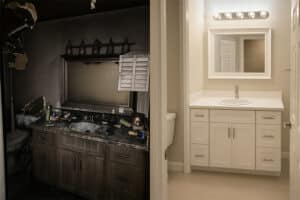In the multifamily sector, every selection that an interior designer or an owner makes is influenced by its asset class. One of the key selections in this also includes hard surface choices such as flooring. As experienced multifamily general contractors, we understand how flooring decisions make a huge impact on the overall look and feel of the project and are heavily influenced by the building’s asset class, tenant demographics, location, and long-term investment goals. From premium hardwood in Class A towers to durable vinyl in workforce housing, understanding how hard surface flooring fits into the bigger picture is essential for a successful apartment renovation strategy.
Table of Contents
ToggleUnderstanding Asset Classes and Their Impact
Multifamily property is generally segmented into four asset classes; Class A, B, C, and D – distinguished by their age, amenities, location, and tenant profile.
- Class A
Newly built or newly renovated buildings in optimal locations that tend to attract high-income tenants. - Class B
Well-maintained older assets in good neighborhoods. The buildings are generally appealing to middle-income, blue-collar tenants. - Class C
Older buildings in less affluent neighborhoods, frequently with deferred maintenance problems. Tenants can be low-to-moderate income families. - Class D
Distressed buildings in economically distressed neighborhoods, frequently needing major repairs.
Each class of building brings a different expectation; not only in rent but also in finishes, durability, and appearance.
Class A: Style Meets Performance
In Class A buildings, flooring isn’t just a finish, it’s a feature. Tenants in luxury units expect high-end materials such as:
- Engineered hardwood
- Porcelain tile
- Wide-plank luxury vinyl tile (LVT)
Here, the emphasis is on elegance, durability, and comfort. High-density LVT, with realistic wood or stone visuals and a soft underfoot feel, is increasingly popular due to its water resistance and acoustic performance; critical in high-rise living.
Cost isn’t the constraint- tenant experience is. Renters are paying a premium and expect a polished product. However, sustainability and ease of maintenance still factor in. Choosing long-life-cycle materials that reduce replacement frequency protects ownership’s operating income over time.
Class B: Value-Driven and Upgrade-Oriented
Class B properties sit at the sweet spot for multifamily renovations. Investors and owners often pursue value-add strategies here; revitalizing units with durable yet cost-efficient materials that appeal to a broad renter base.
Common flooring choices in Class B renovations include:
- Luxury vinyl plank (LVP)
Offers a hardwood look at a fraction of the cost, with excellent durability. - Laminate flooring
More budget-friendly than LVP, though less resistant to moisture.
Tenant profiles in Class B buildings are typically working professionals or families seeking quality and reliability. Flooring selections must be attractive, easy to clean, and stand up to everyday wear and tear.
Sound reduction and water resistance are critical in reducing turnover costs. In-unit washer/dryers, pet-friendly policies, and kids mean floors have to work harder and smarter.
Class C: Durability Above All
In Class C properties, flooring must stretch every renovation dollar. These units often serve as workforce housing in developing neighborhoods, and many suffer from deferred maintenance. Flooring is selected with affordability and durability as the guiding principles.
Common materials include:
- Base-grade LVT or LVP
- Laminate
- Vinyl sheet flooring
- Commercial-grade carpet in bedrooms
Carpet is still used in many bedrooms to reduce noise complaints in older buildings without underlayment, but hard surfaces dominate in kitchens, baths, and high-traffic areas. Importantly, materials should be easy to replace in small sections to reduce unit downtime during turnover.
In Class C renovations, we often focus on low-cost improvements that still enhance resident satisfaction and extend hold value for owners.
Location and Demographics Matter Too
Asset class isn’t the only factor. Geographic region, climate, and tenant demographics also influence flooring choices:
- In humid climates, waterproof flooring like LVP is favored over laminate.
- In urban centers, aesthetics matter more to attract renters with higher expectations, even in Class B buildings.
- In student housing, which can range from Class B to C, durability and low replacement cost rules.
Knowing the resident profile is essential. For example, pet-friendly properties need scratch-resistant surfaces, while communities with aging tenants may prioritize slip resistance and soft underfoot textures.
When it comes to apartment renovation strategy, flooring is one of the most visible and influential elements of unit perception, and rent justification. As multifamily general contractors, we at Renu help owners align flooring choices with asset class, budget, and investment goals, ensuring that every dollar spent contributes to NOI (Net Operating Income) growth and long-term value. Whether you’re repositioning a Class C asset or polishing a Class A tower, your flooring choices matter.
#MultiFamilyRenovations #AssetClass #Texas #MultifamilyGeneralContractors #Atlanta #MultifamilyRealEstate #Houston #Denver #RenovationCompany #ApartmentRenovations #RemovationContractor #ApartmentFlooring #MultifamilyUnitRenovation







